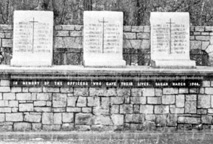Infamous and famous
| The 'Great
Escape'
from Stalag Luft III at Sagan in March 1944 resulted
in the murder of 50 aircrew escapees by the
Nazi Gestapo and SS.
The POW camp in Europe perhaps best known to the public was the supposedly escape-proof Colditz Castle, where persistent escapers were incarcerated. Even from here, specially trained prisoners, as in other camps, were able to send valuable intelligence information by clandestine means. |
 Memorial at Sagan to the 50 murdered 'Great Escapers'. |
Aircrew received training on what to expect in terms of interrogation. For the majority of Allied POWs in Europe, their imprisonment was a time to be endured. Irritating the enemy, maintaining fitness, improving education and skills all helped to pass the time.
The main problems were boredom, hunger, and concern about family and friends. Towards the end malnutrition had become critical in some camps in Europe: forced marches to move POWs westwards took their toll.
In Japanese camps, survival was all: the Burma-Siam Railway took a heavy toll of prisoners used as forced labour, mainly though disease; the losses among non-European prisoners were even more horrendous.